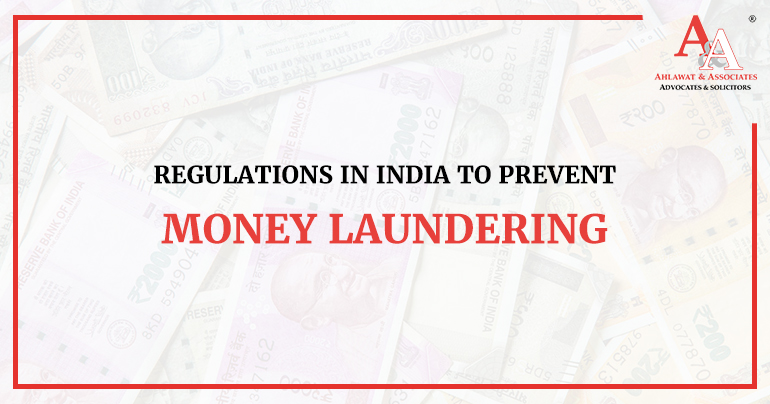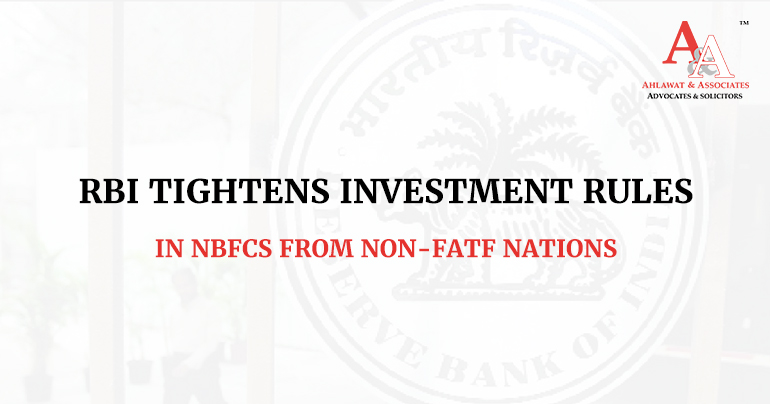
Money laundering is a common issue around the globe. In recent times, money laundering and terror financing have forced several governments and regulators globally to focus on stopping the illegitimate flow of funds. However, combating this problem remains a primary challenge for nations and financial institutions all over the world.
The legalization of crime revenues has numerous damaging and negative outcomes. Financial crimes result in the deterioration of the administrative order and economic stability. Governments have taken several measures from the past to prevent money laundering. The objective of these measures is to prevent financial crimes and ensure that the administrative and economic stability of the nation is maintained.
Anti-money laundering (AML) in India is described as a set of regulations, laws or procedures particularly designed to prevent the activity of generating money via illegal ways and methods. The Prevention of Money Laundering Act, 2002 (PMLA) along with the Prevention of Money Laundering (Maintenance of Records) Rules, 2005 (Rules) are the principal laws that are enforced to prohibit money laundering activities in India.
There are specialised authorities that deal with the money laundering problems such as the Reserve Bank of India/ Securities and Exchange Board of India (SEBI)/ Insurance Regulatory and Development Authority of India that lay down guidelines on anti-money laundering standards following PMLA and Rules.
The Financial Action Task Force on Money Laundering (FATF), an intergovernmental body introduced by the G-7 Summit in Paris in 1989 and responsible for setting global standards on anti-money laundering and combating the financing of terrorism explains money laundering as the processing of criminal proceeds to disguise their illegitimate origin to legitimize the illegal gains of crime.
In 2010, India became the 34th nation member of the Financial Action Task Force. India is one of the signatories to several United Nations Conventions which tackle anti-money laundering and countering the financing of terrorism. India has prohibited money laundering under the Prevention of Money Laundering Act, 2002 (PMLA) and also in the Narcotic Drugs and Psychotropic Substances Act, 1985 (NDPS Act) (amended in 2001).
The Prevention of Money Laundering Act 2002 coupled with the rules issued under it and the rules and regulations formed by regulators such as the Reserve Bank of India (RBI) and the Securities and Exchange Board of India (SEBI) displays a broad framework for the anti-money laundering laws in India.
In 1998, The Prevention of Money Laundering Bill was introduced in the Lok Sabha, passed in 2003 and came into force in 2005. It has gone through several amendments, with the last one being in 2019. Administration and enforcement authorities are chosen under PMLA to execute its provisions and rules. Certain powers are vested, which are very similar to those granted to the civil courts of the nation, to exercise the provisional attachment of properties that are involved in the offence under PMLA.
The PMLA attempts to combat acts related to money laundering in India and because of this, it has three main objectives i.e.
(i) to prevent and control money laundering
(ii) to confiscate and seize the property acquired from the laundered money
(iii) to deal with any other issue in relation to money laundering in India.
Under the provisions of the PMLA, the Financial Intelligence Unit of India (FIU-IND) was formed in 2004 as the primary body for coordinating India’s AML efforts. The primary function of FIU-IND is to receive, analyse, process and disseminate information relating to suspect financial transactions. FIU-IND also coordinate and strengthen efforts of national investigation, international intelligence and enforcement agencies in pursuing the global efforts against money laundering and financing of terrorism. In 2005, the Enforcement Directorate (ED) was introduced by the Government of India to utilize exclusive powers related to the investigation and prosecution under PMLA.
The primary legislation other than the Prevention of Money Laundering Act, 2002, which directly or indirectly focuses to curb and fight money laundering activities are as follows:
The act was passed in 1974 in furtherance to the government attempt to retain foreign exchange within the nation. The Act is established on the concept of Preventive Detention which, apart from being a colonial legacy, is also given explicitly in our constitution as ‘the necessary evil’ and laws exist under Article 22 of the Indian Constitution for the same reasons related to the security of the state and maintenance of public order. According to the provisions of section 10, the stipulated period of detention is 1 to 2 years.
All decisions in furtherance of the Act may be taken by the state or central government. The relevant provisions in this regard which must be taken into consideration are Section 3 (power to make orders detaining certain persons), Section 4 (execution of detention orders), Section 5 (power to regulate place and conditions of detention), and Section 11 (revocation of detention orders).
A Benami transaction is a transaction in which property is transferred to one person for a value paid or provided by another person and often, the identity of the persons involved is concealed. This Act was passed in 1988. It is to constrain Benami transactions and the right to recover property held by the Benami. Section 3 of the Act specifically debars anyone from getting into a Benami transaction. The Act further specifies those properties obtained under the Benami transaction which are liable to be acquired by the competent authorities without any need of compensation to be payable by such authority.
The Indian Penal Code, 1860 is the primary substantive law that regulates a number of criminal activities and also prescribes penalties for them. The Code of Criminal Procedure, 1973 on the other hand is a part of procedural law that specify procedures to be followed in criminal cases. A number of offences under the Indian Penal Code have been recognised as being scheduled offences within the meaning explained in the PMLA. Further, Section 65 of the PMLA also specify that the provisions of the Code of Criminal Procedure are to be followed in respect of the several proceedings prescribed under the PMLA.
This Act was passed in 1985 with the aim of consolidation and amendment of laws relating to narcotic drugs. Keeping in line with its objectives identifies, lists, and explains several forms and types of narcotic drugs and psychotropic substances.
The Act, in its essence attempts to stop and restrict the transport and vending of narcotic and psychotropic substances and does not mention money laundering activities. It may, however, be taken into consideration that the trade of narcotic substances does generate a lot of cash for people involved in it. So much so that a noticeable portion of the money involved in drug trafficking is then mobilised to give it legitimacy or in simple words, the same money gets laundered. The NDPS Act, by working against practices involving drug trading and trafficking puts a direct restriction on the flow of money into illegitimate activities.
Money Laundering is a universal menace and cannot be resolved by a single nation alone. The activities related to money laundering have been spreading in the Indian society, despite the best efforts of the Indian government to stop such practices. Through legislation and administrative bodies and efficient regulators who work tirelessly in this matter, the fight against money laundering activities continues to go on.
Although such activities may be controlled at a domestic level, such practices are never restricted to the confines of a single jurisdiction. Restrictions at a specific jurisdiction motivate launderers to shift base to another jurisdiction which may give a hospitable environment for their activities to grow.
It may be noted that funds brought in by illegitimate ways for legitimisation, once legalised, be again utilised for the vested interests of the beneficiaries who may not always have good intentions in mind. Crime can only result in more crime and the vicious circle would only continue. Whereas checks are required to be maintained regularly on money laundering activities- one of the better methods to stop money laundering practices may be for governments to introduce such legitimate interests into confidence and provide them protection and certain benefits which may altogether restrict people from engaging in money laundering activities.
The Prevention of Money Laundering Act and Rules apply to all persons which cover individuals, companies, firms, an association of persons or a body of individuals and any agency, office/branch owned or managed by any of the above persons.
Anyone who directly or indirectly tries to indulge or knowingly assists or is actually involved in any activity related to the proceeds of crime is guilty of the offence of money laundering. Further, concealment, acquisition, possession or utilising and project or claim it as untainted property of such proceeds of crime in any way is also an offence under the provisions of The Prevention of Money Laundering Act.
The Prevention of Money Laundering Act prescribes imprisonment for a minimum of 3 years which may extend up to 7 years and also a fine. In the situation where the offence of money laundering is related to the Narcotic Drugs and Psychotropic Substances Act, 1985, the imprisonment may extend up to 10 years.
If money laundering is committed by a company, then every person responsible for the conduct of the company at the time of such activity as well as the company will be considered guilty and will be liable to be proceeded against and punished accordingly.
Ministry of Finance, The Directorate of Enforcement in the Department of Revenue is responsible for investigating offences of money laundering. The Financial Intelligence Unit - India (FIU-IND) under the Department of Revenue, Ministry of Finance is the central national agency whose duty is to receive, process, analyse, and disseminate information regarding the suspected financial transactions to enforcement agencies and foreign FIUs.
Under the Prevention of Money Laundering Act, ‘property’ means any property/assets of every description, movable or immovable, corporeal or incorporeal, tangible or intangible and consist deeds and instruments evidencing title/interest in the property/assets wherever situated and covers any kind of property used in the commission of an offence under the Prevention of Money Laundering Act.

The Reserve Bank of India (RBI) has rationalized the end-use provisions of External Commercial Borrowings
View More
The Reserve Bank of India, vide its circular number RBI/2020-2021/97 dated February 12, 2021, imposed
View More
The Reserve Bank of India (“RBI”) through its recent press release no. 2023-2024/765 dated August 17, 2023,
View More















 Cookies Consent
Cookies ConsentWe use cookies to help you navigate efficiently and perform certain functions. You will find detailed information about all cookies under each consent category below. Read more...
 Cookies Consent
Cookies ConsentWe use cookies to help you navigate efficiently and perform certain functions. You will find detailed information about all cookies under each consent category below. Read more...


Comments
Post A Comment
Your email address will not be published *